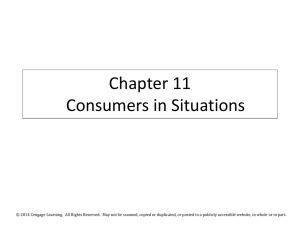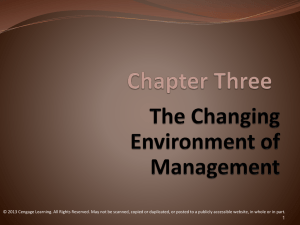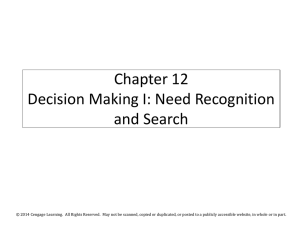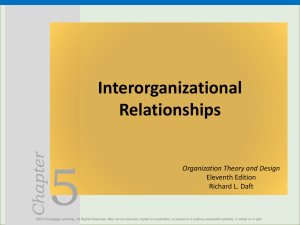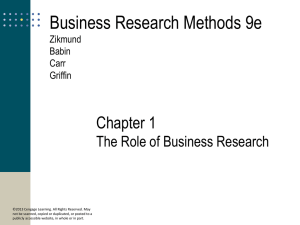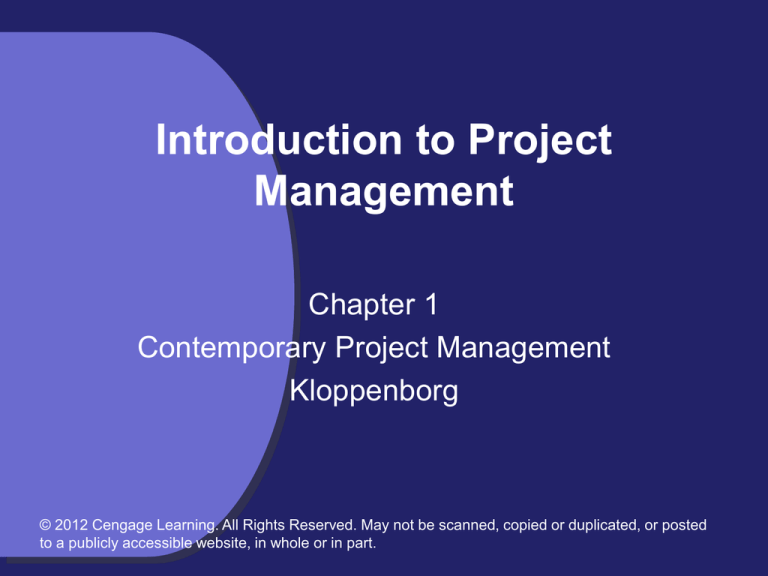
Introduction to Project
Management
Chapter 1
Contemporary Project Management
Kloppenborg
© 2012 Cengage Learning. All Rights Reserved. May not be scanned, copied or duplicated, or posted
to a publicly accessible website, in whole or in part.
Chapter
Vignette
The Element of Discipline
• Deaths climbing Mt. Aconcagua are an extreme
example of consequences associated with a lack
of discipline
• Discipline to act on the earlier decision to curtain
summit attempts after the agreed-to-turn-around
time or in severe weather
• Avoid pressure to cast aside or shortcut project
management practices
• Practices, like planning, are the pillars of project
management discipline
© 2012 Cengage Learning. All Rights Reserved. May not be scanned, copied or duplicated, or posted
to a publicly accessible website, in whole or in part.
Chapter
Vignette
The Element of Discipline
• Managing projects at the CIA involved short
notice to acquire unspent funds
• Discipline required needed planning and quick
action
• The top 2 percent of project managers spend
twice as much time planning as the other 98
percent
• Identify those pillars that we will decide to
practice with the required levels of discipline
© 2012 Cengage Learning. All Rights Reserved. May not be scanned, copied or duplicated, or posted
to a publicly accessible website, in whole or in part.
At the end of this chapter…
• Define a project using characteristics that are
common to most projects and describe reasons
why more organizations are using project
management.
• Describe major activities and deliverables, at
each project life cycle stage.
• List and define the nine knowledge areas and
five process groups of the project management
body of knowledge (PMBOK®).
© 2012 Cengage Learning. All Rights Reserved. May not be scanned, copied or duplicated, or posted
to a publicly accessible website, in whole or in part.
At the end of this chapter…
• Delineate measures of project success and
failure and reasons for both.
• Identify project roles and distinguish key
responsibilities for each.
© 2012 Cengage Learning. All Rights Reserved. May not be scanned, copied or duplicated, or posted
to a publicly accessible website, in whole or in part.
What is a project?
Project – “a temporary endeavor undertaken to
create a unique product, service, or result.” PMBOK®
Guide
• A project requires an organized set of work
efforts.
• Projects require a level of detail that is
progressively elaborated upon as more
information is discovered.
• Projects are subject to limitations of time and
resources such as money and people.
• Projects have a defined beginning and ending.
© 2012 Cengage Learning. All Rights Reserved. May not be scanned, copied or duplicated, or posted
to a publicly accessible website, in whole or in part.
What is a project?
• A project has a unique combination of
stakeholders
stakeholders – “persons or organizations … that are
actively involved in the project, or whose interests may
be positively or negatively affected by execution or
completion of the project.” PMBOK® Guide
© 2012 Cengage Learning. All Rights Reserved. May not be scanned, copied or duplicated, or posted
to a publicly accessible website, in whole or in part.
Project Management (PM)
• PM includes work processes that initiate, plan,
execute, and close work
• Work processes require tradeoffs among the
scope, quality, cost, and schedule of the project
• PM includes administrative tasks for planning,
documenting, and controlling work
• PM includes leadership tasks for visioning,
motivating, and promoting work associates.
• PM knowledge, skills, and methods apply for
most projects
Project management – “the application of knowledge,
skills, tools and techniques to project activities to meet
© 2012 Cengage Learning. All Rights Reserved. May not be scanned, copied or duplicated, or posted
project
requirements.”
Guide
to a publicly
accessible
website, in whole or inPMBOK®
part.
History of Project Management
• PM emerged as a formal discipline in the 1950s
• Techniques for planning and controlling
schedules and costs were developed for huge
aerospace and construction projects in the
1950s and 1960s
• Early PM involved determining project schedules
based on order of project activities
• Manufacturing, research and development,
government, and construction projects used and
refined management techniques
© 2012 Cengage Learning. All Rights Reserved. May not be scanned, copied or duplicated, or posted
to a publicly accessible website, in whole or in part.
History of Project Management
• Software companies offered software for planning
and controlling project costs and schedules in the
1980s and 1990s
• Risk management techniques for complex
projects have been applied to less complex
projects
• Communication and leadership playa major role in
project success
• Rapid growth and change in information
technology and telecommunications fueled use of
PM in the 1990s and 2000s
© 2012 Cengage Learning. All Rights Reserved. May not be scanned, copied or duplicated, or posted
to a publicly accessible website, in whole or in part.
How Can Project Work Be
Described?
• Projects are temporary and unique; operations
are more continuous.
• Project managers need “soft skills” and “hard
skills” to be effective.
• Project managers frequently have more
responsibility than authority.
• Projects go through predictable stages called a
life cycle.
© 2012 Cengage Learning. All Rights Reserved. May not be scanned, copied or duplicated, or posted
to a publicly accessible website, in whole or in part.
Projects Versus Operations
• Projects are temporary
• Projects have both routine and unique
characteristics
• Operations consist of the ongoing work needed
to ensure that an organization continues to
function effectively
© 2012 Cengage Learning. All Rights Reserved. May not be scanned, copied or duplicated, or posted
to a publicly accessible website, in whole or in part.
Soft Skills and Hard Skills
• Soft skills include communication and leadership
activities.
• Hard skills include risk analysis, quality control,
scheduling, and budgeting work
• A successful project manager needs both soft
and hard skills along with the judgment of when
each is more necessary.
• Training, experience, and mentoring are
instrumental in developing necessary skills.
© 2012 Cengage Learning. All Rights Reserved. May not be scanned, copied or duplicated, or posted
to a publicly accessible website, in whole or in part.
Authority and Responsibility
• Projects are most effectively managed with one
person being assigned accountability
• Project managers negotiate with functional
managers
• A project manager needs to develop strong
communication and leadership skills to persuade
subordinates to focus on the project when other
work beckons.
Functional manager – “someone with management
authority over an organizational unit.…the manager of
any group that actually makes a product or performs a
© 2012 Cengage Learning. All Rights Reserved. May not be scanned, copied or duplicated, or posted
service.”
to a publicly
accessiblePMBOK®
website, in wholeGuide
or in part.
Project Life Cycle
• All projects go through predictable stages called
a project life cycle.
• Life cycle allows for control to assure that the
project is proceeding in a satisfactory manner
and that the results are likely to serve its
customer’s intended purpose
Project life cycle – “a collection of generally sequential
project phases whose name and number are determined
by the control needs of the organization or organizations
involved in the project.” PMBOK® Guide
© 2012 Cengage Learning. All Rights Reserved. May not be scanned, copied or duplicated, or posted
to a publicly accessible website, in whole or in part.
Project Life Cycle Stages
• Selecting and initiating— a project is proposed,
planned at a high level, and key participants commit to it
in broad terms
• Planning—starts after the initial commitment, includes
detailed planning, and ends when all stakeholders
accept the entire detailed plan.
• Executing—includes authorizing, executing, monitoring,
and controlling work until the customer accepts the
project deliverables.
• Closing and realizing—all activities after customer
acceptance to ensure project is completed, lessons are
learned, resources are reassigned, contributions are
recognized, and benefits are realized.
© 2012 Cengage Learning. All Rights Reserved. May not be scanned, copied or duplicated, or posted
to a publicly accessible website, in whole or in part.
Project Life Cycle Stages
• Most companies insist that a project must pass
an approval of some kind to move from one
stage to the next
• The project life cycle is highly formalized and
very specific
• Projects are measured at selection, progress
reporting, and benefits realization points
© 2012 Cengage Learning. All Rights Reserved. May not be scanned, copied or duplicated, or posted
to a publicly accessible website, in whole or in part.
Project Life Cycle Stages
© 2012 Cengage Learning. All Rights Reserved. May not be scanned, copied or duplicated, or posted
to a publicly accessible website, in whole or in part.
Life Cycle for Quality Improvement
Projects
© 2012 Cengage Learning. All Rights Reserved. May not be scanned, copied or duplicated, or posted
to a publicly accessible website, in whole or in part.
Understanding Projects
• Project Management Institute
• Project Management Body of Knowledge
(PMBOK)
• Selecting and Prioritizing Projects
• Project Goals and Constraints
• Defining Project Success and Failure
• Using MS Project
• Types of Projects
• Scalability of Project Tools
© 2012 Cengage Learning. All Rights Reserved. May not be scanned, copied or duplicated, or posted
to a publicly accessible website, in whole or in part.
The Project Management Institute
• The largest professional organization
• Publishes and regularly updates A Guide to the
Project Management Body of Knowledge
(PMBOK® Guide)
• Established a professional certification - Project
Management Professional (PMP®)
• Established a second certification—Certified
Associate in Project Management (CAPM)
© 2012 Cengage Learning. All Rights Reserved. May not be scanned, copied or duplicated, or posted
to a publicly accessible website, in whole or in part.
Project Management Body of
Knowledge (PMBOK®
• Consists of a project life cycle, five process
groups, and nine knowledge areas
Project management process group – “a logical
grouping of the project management inputs, tools and
techniques, and outputs.” PMBOK® Guide
© 2012 Cengage Learning. All Rights Reserved. May not be scanned, copied or duplicated, or posted
to a publicly accessible website, in whole or in part.
PMBOK® Process Groups
Initiating—“defines and authorizes a project or a project
phase”
Planning—“defines and refines objectives and plans
actions to achieve objectives”
Executing—“directs and manages people and other
resources to accomplish project work”
Monitoring and controlling—“collects data and checks
progress to determine any needed corrective actions”
Closing—“formalized acceptance of project outcomes
and ending the project”
© 2012 Cengage Learning. All Rights Reserved. May not be scanned, copied or duplicated, or posted
to a publicly accessible website, in whole or in part.
PMBOK® Knowledge Areas
Integration management—“processes and activities
needed to define, combine, unify, and coordinate the
various processes and project management activities”
Scope management—“processes required to ensure
that the project includes all the work required, and only
the work required, to complete the project successfully”
Time management—“processes required to manage
timely completion of the project”
Cost management—“processes involved in estimating,
budgeting, and controlling costs so that the project can
be completed within the approved budget”
Quality management—“processes and activities of the
performing organization that determine quality policies,
objectives, and responsibilities so that the project will
satisfy the needs for which it was undertaken”
© 2012 Cengage Learning. All Rights Reserved. May not be scanned, copied or duplicated, or posted
to a publicly accessible website, in whole or in part.
PMBOK® Knowledge Areas
Human Resources management—“processes that
organize, manage, and lead the project team”
Communications management—“processes required
to ensure timely and appropriate generation, collection,
distribution, storage, retrieval, and ultimate disposition of
project information”
Risk management—“processes of conducting risk
management planning, response planning, and
monitoring and control … to increase the probability and
impact of positive events and decrease the probability
and impact of negative events in the project”
Procurement management—“processes necessary to
purchase or acquire products, services, or results from
outside the project team”
© 2012 Cengage Learning. All Rights Reserved. May not be scanned, copied or duplicated, or posted
to a publicly accessible website, in whole or in part.
Selecting and Prioritizing Projects
• Identify potential projects
• All parts of the organization are involved
• Determine which projects align best with major
goals of the firm
• Ensure overall organizational priorities are
understood, communicated, and accepted
© 2012 Cengage Learning. All Rights Reserved. May not be scanned, copied or duplicated, or posted
to a publicly accessible website, in whole or in part.
Selecting and Prioritizing Projects
What value does each potential
project bring to the organization?
Are the resources
needed to perform the
project available?
Are the demands of
performing each project
understood?
Which projects will
best help the
organization achieve
its goals?
Is there enthusiastic
support both from the
external customers
and from one or more
© 2012 Cengage Learning. All Rights Reserved. May not be scanned, copied or duplicated, or posted
internal
to a publicly
accessiblechampions?
website, in whole or in part.
Project Goals and Constraints
• Projects are undertaken to accomplish specific
goals
• Scope and quality measure performance and
should result in outputs that satisfy customers
• Consider scope and quality subject to
constraints of time and cost
Scope – “the sum of all products, services, and results
to be provided as a project.” PMBOK® Guide
Quality – “the degree to which a set of inherent
© 2012 Cengage Learning. All Rights Reserved. May not be scanned, copied or duplicated, or posted
characteristics
PMBOK® Guide
to a publicly
accessible website,fulfills
in whole orrequirements.”
in part.
Project Goals and Constraints
• Obstacles or challenges may limit the ability to
perform
• Opportunities may allow projects to exceed
original expectations.
• Project Managers (PMs) decide which goals and
constraints take precedence
© 2012 Cengage Learning. All Rights Reserved. May not be scanned, copied or duplicated, or posted
to a publicly accessible website, in whole or in part.
Project Customer Tradeoff Matrix
© 2012 Cengage Learning. All Rights Reserved. May not be scanned, copied or duplicated, or posted
to a publicly accessible website, in whole or in part.
Defining Project Success and
Failure
• Project success is creating deliverables that
include all of the agreed upon features
• Outputs please the project’s customers.
• Customers use the outputs effectively as they do
their work (meet quality goals)
• The project should be completed on schedule
and on budget (meet time and cost constraints).
© 2012 Cengage Learning. All Rights Reserved. May not be scanned, copied or duplicated, or posted
to a publicly accessible website, in whole or in part.
Defining Project Success and
Failure
• Successful projects are completed without
heroics
• People who work on the project should learn
new skills and/or refine existing skills.
• Organizational learning should take place and
be captured for future projects.
• Reap business-level benefits such as
development of new products, increased market
share, increased profitability, decreased cost,
etc.
© 2012 Cengage Learning. All Rights Reserved. May not be scanned, copied or duplicated, or posted
to a publicly accessible website, in whole or in part.
Project Success
•Meeting Agreements
•Cost, schedule, and specifications met
•Customer’ Success
•Needs met, deliverables used, customer
satisfied
•Performing Organization’s Success
•Market share, new products, new technology
•Project Team’s Success
•Loyalty, development, satisfaction
© 2012 Cengage Learning. All Rights Reserved. May not be scanned, copied or duplicated, or posted
to a publicly accessible website, in whole or in part.
Why Projects Fail
• Not enough resources are available for project
completion.
• Not enough time has been given to the project.
• Project expectations are unclear.
• Changes in the scope are not understood or
agreed upon by all parties involved.
• Stakeholders disagree regarding expectations
for the project.
• Adequate project planning is not used.
© 2012 Cengage Learning. All Rights Reserved. May not be scanned, copied or duplicated, or posted
to a publicly accessible website, in whole or in part.
Types of Projects
• Classifying by industry
• Classifying by size
• Classifying by timing of determination of project
scope
• Classifying by application
© 2012 Cengage Learning. All Rights Reserved. May not be scanned, copied or duplicated, or posted
to a publicly accessible website, in whole or in part.
PMI Communities of Practice
• Projects in
different
industries often
have unique
requirements
• PMI specific
interest groups
Aerospace and Defense
Agile
Automation Systems
Consulting
Design-ProcurementConstruction
Diversity
E-Business
Financial Services
Global Sustainability
Government
Healthcare
Human Resource
Information Systems
Innovation and New Product
Development
International Development
Learning, Education and
Development
Manufacturing
Marketing and Sales
Oil, Gas, Petrochemical
Organizational
Performance
Management
Pharmaceutical
Program Management
Office
Quality
Retail
Risk Management
Scheduling
Service and
Outsourcing
Students of PM
Troubled Projects
Utility
Women in PM
Classifying by Size
Large projects often
require more
detailed planning
and control
© 2012 Cengage Learning. All Rights Reserved. May not be scanned, copied or duplicated, or posted
to a publicly accessible website, in whole or in part.
Classifying by Timing of Project Scope
Clarity
How early in the
project the project
manager and team
are likely to be able to
determine what the
project scope will be
© 2012 Cengage Learning. All Rights Reserved. May not be scanned, copied or duplicated, or posted
to a publicly accessible website, in whole or in part.
Classification by Application
• All projects require planning and control
• The art of project management deals with when
to use certain techniques, how much detail to
use, and how to tailor the techniques to the
needs of a specific project.
© 2012 Cengage Learning. All Rights Reserved. May not be scanned, copied or duplicated, or posted
to a publicly accessible website, in whole or in part.
Scalability of Project Tools
• All projects require
– Determination of the wants and needs of the
customer(s)
– Understanding of the amount of work involved
– Determination of a budget and schedule
– Decisions about available workers and who will do
which tasks
– Management until the owner accepts the project
results
• Projects are scaled up or down to meet the
complexity of the task
© 2012 Cengage Learning. All Rights Reserved. May not be scanned, copied or duplicated, or posted
to a publicly accessible website, in whole or in part.
Project Roles
• Project Executive-Level Roles
• Project Management-Level Roles
• Project Associate-Level Roles
© 2012 Cengage Learning. All Rights Reserved. May not be scanned, copied or duplicated, or posted
to a publicly accessible website, in whole or in part.
Project Executive-Level Roles
• The steering team
– The top leader (CEO) and his/her direct reports
– Select, prioritize, and resource projects in
accordance with the organization’s strategic
planning
– Ensure that accurate progress is reported and
necessary adjustments are made.
© 2012 Cengage Learning. All Rights Reserved. May not be scanned, copied or duplicated, or posted
to a publicly accessible website, in whole or in part.
Project Executive-Level Roles
• The chief projects officer
– Keeper, facilitator, and improver of the project
management system
– Responsible for project standards, methods,
training, documentation
Project Management Office (PMO) – “an organizational
body or entity assigned various responsibilities related to the
centralized and coordinated management of those projects
within its domain. The responsibilities of the PMO can range
from providing project management support functions to
actually being responsible for the direct management of a
© 2012 Cengage Learning. All Rights Reserved. May not be scanned, copied or duplicated, or posted
project.” PMBOK® Guide
to a publicly accessible website, in whole or in part.
Project Executive-Level Roles
• The sponsor
– Takes an active role in chartering the project and
reviewing progress reports
– Takes a behind-the-scenes role in mentoring and
assisting the project manager throughout the
project life.
Sponsor – “the person or group that provides the financial
resources, in cash or in kind, for the project.” PMBOK®
Guide
© 2012 Cengage Learning. All Rights Reserved. May not be scanned, copied or duplicated, or posted
to a publicly accessible website, in whole or in part.
Project Management-Level Roles
• Project manager
– Directly accountable for the project results, schedule,
and budget
– The main communicator
– Responsible for the planning and execution of the
project
– Works on the project from start to finish.
– The project manager often must get things done
through the power of influence since his or her formal
power may be limited.
Project manager – “the person assigned by the performing
organization to achieve the project objectives.” PMBOK®
© 2012 Cengage Learning. All Rights Reserved. May not be scanned, copied or duplicated, or posted
to aGuide
publicly accessible website, in whole or in part.
Project Management-Level Roles
• Functional manager
– The department heads—the ongoing managers of the
organization
– Determine how the work of the project is to be
accomplished
– Supervise the work
– Negotiate with the project manager regarding which
workers are assigned to the project
© 2012 Cengage Learning. All Rights Reserved. May not be scanned, copied or duplicated, or posted
to a publicly accessible website, in whole or in part.
Project Management-Level Roles
• Facilitator
– Helps the project manager with the process of
running meetings and making decisions
– Frees the project manager to concentrate on the
content of the project
– The facilitator concentrates on the process.
– A facilitator helps the PM understand organizational
politics and provides suggestions on how to handle
situations.
© 2012 Cengage Learning. All Rights Reserved. May not be scanned, copied or duplicated, or posted
to a publicly accessible website, in whole or in part.
Project Management-Level Roles
• Senior customer representative
– Ensures that the needs and wants of constituents in
the customer’s organization are identified and
prioritized
– Ensures that project progress and decisions
continually support the customer’s desires.
© 2012 Cengage Learning. All Rights Reserved. May not be scanned, copied or duplicated, or posted
to a publicly accessible website, in whole or in part.
Project Associate-Level Roles
• Core team member
– People assigned to a project from start to finish
– The core team does most of the planning and makes
most of the project level decisions.
Project management team – “members who are
directly involved in project management activities.”
PMBOK® Guide
© 2012 Cengage Learning. All Rights Reserved. May not be scanned, copied or duplicated, or posted
to a publicly accessible website, in whole or in part.
Overview of the Book
• Project management is integrative, iterative, and
collaborative
• This book has three major parts
– Organizing and Initiating Projects
– Planning Projects
– Performing Projects
© 2012 Cengage Learning. All Rights Reserved. May not be scanned, copied or duplicated, or posted
to a publicly accessible website, in whole or in part.
Part I - Organizing and Initiating
Projects
• Project management basics (Chapter 1)
• Project selection and prioritization (Chapter 2)
• Organizational structure, organizational culture,
project life cycle, and project management roles
of the parent organization (Chapter 3)
• Chartering projects (Chapter 4)
Project charter – “a document issued by the project initiator
or sponsor that formally authorizes the existence of a
project, and provides the project manager with the authority
to apply organizational resources to project activities.”
PMBOK® Guide
© 2012 Cengage Learning. All Rights Reserved. May not be scanned, copied or duplicated, or posted
to a publicly accessible website, in whole or in part.
Part II – Planning Projects
• Identify project stakeholders, their wants and
needs, and how to prioritize decisions among
them (Chapter 5)
• How to determine the project scope and outline
it in the work breakdown structure (WBS)
(Chapter 6)
Work breakdown structure (WBS) – “a deliverableoriented hierarchical decomposition of the work to be
executed by the project team to accomplish the project
objectives and create the required deliverables. It organizes
and defines the total scope of the project.” PMBOK® Guide
© 2012 Cengage Learning. All Rights Reserved. May not be scanned, copied or duplicated, or posted
to a publicly accessible website, in whole or in part.
Part II – Planning Projects
•
•
•
•
•
Scheduling projects (Chapter 7)
Scheduling resources on projects (Chapter 8)
Project budgeting (Chapter 9)
Risk planning (Chapter 10)
Project Quality (Chapter 11)
Project schedule – “the planned dates for performing
schedule activities and the planned dates for meeting
schedule milestones.” PMBOK® Guide
Budget – “the approved estimate for the project or
any work breakdown structure component or any
© 2012 Cengage Learning. All Rights Reserved. May not be scanned, copied or duplicated, or posted
schedule
Guide
to a publicly
accessibleactivity.”PMBOK®
website, in whole or in part.
Part III – Performing Projects
•
•
•
•
Project supply chain management (Chapter 12)
Leading and managing project teams (Chapter 13)
Monitoring and controlling project work (Chapter 14)
Finishing projects and realizing benefits (Chapter 15)
Monitor and control project work – “the process of
tracking, reviewing, and regulating the progress to meet
the performance objectives defined in the project
plan”PMBOK® Guide
Close project – “the process of finalizing all activities
across all of the project process groups to formally close
a project or phase.” PMBOK® Guide
© 2012 Cengage Learning. All Rights Reserved. May not be scanned, copied or duplicated, or posted
to a publicly accessible website, in whole or in part.
Summary
• A project is an organized set of work efforts undertaken
to produce a unique output subject to limitations of time
and resources such as money and people
• Project management includes work processes that
initiate, plan, execute, control, and close project work.
• Tradeoffs must be made between the scope, quality,
cost, and schedule
• All projects, regardless of size, complexity, or
application, need to be planned and managed.
• PMI® is a large professional organization devoted to
promoting and standardizing project management
understanding and methods
© 2012 Cengage Learning. All Rights Reserved. May not be scanned, copied or duplicated, or posted
to a publicly accessible website, in whole or in part.
Summary
• A Guide to the Project Management Body of Knowledge
(PMBOK® Guide), is composed of five process groups:
initiating, planning, executing, monitoring and controlling,
and closing along with nine knowledge areas: cost, time,
scope, quality, risk, communications, human resources,
procurement, and integration.
• Successful projects require an understanding of what
project success is and what drives it
• Successful projects require an understanding of project
failure and its major causes.
• Project management requires an understanding of the
various executive, managerial, and associate roles in
project management
© 2012 Cengage Learning. All Rights Reserved. May not be scanned, copied or duplicated, or posted
to a publicly accessible website, in whole or in part.
Skyline Chili, Inc.
• Cincinnati-based restaurant franchise with menu
specializing in high-quality chili-related food
products
• Customers value unparalleled hospitality
• Skyline management wanted to ensure training
program aligns with business plan of
unparalleled hospitality
• Required outcome: high-performing, executionready, hospitable employees
PM in Action Example
© 2012 Cengage Learning. All Rights Reserved. May not be scanned, copied or duplicated, or posted
to a publicly accessible website, in whole or in part.
Skyline Chili, Inc.
• Brainstorming and prioritizing identified critical
training projects
• Top priority was to establish a centralized
training department with a point contact person
• Training department was not planned or
budgeted
• As a result of a business case and job analysis a
director of training was put in place
PM in Action Example
© 2012 Cengage Learning. All Rights Reserved. May not be scanned, copied or duplicated, or posted
to a publicly accessible website, in whole or in part.
PM in Action Example
Skyline Chili, Inc.
© 2012 Cengage Learning. All Rights Reserved. May not be scanned, copied or duplicated, or posted
to a publicly accessible website, in whole or in part.


